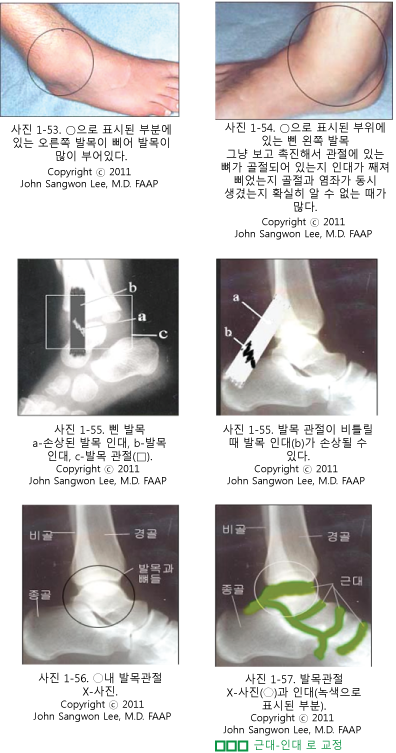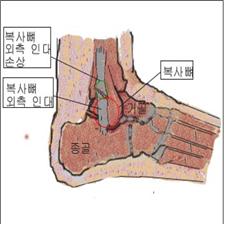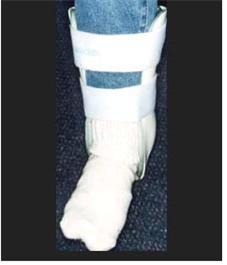Ankle sprains 발목 염좌(발목 삠)
Overview of ankle sprains
-
A wound in which a joint is suddenly twisted and part or all of the ligaments forming the joint is torn is called a sprain or torsion.
-
Ankle sprains, sprained ankles, or “sprained ankles” are described as ankle sprains, sprained ankles, and slit ligaments.
Figure 1-17. Injuries to the sides of the ankle and lateral ankle ligaments Copyright ⓒ 2011 John Sangwon Lee, M.D., FAAP
Causes of ankle sprains
-
A wound in which part or all of the ligaments attached to the joint is torn by moving beyond the range of motion in which the joint can move normally is called a sprain or sprain.
-
While playing a playing or exercising, such as running, joints such as ankles, knees, elbows, shoulders, and fingers may be sprained in an accident.
-
In particular, ankle sprains are more likely to occur when running on the bumpy road, and the external ligaments of the Malleus are most likely to be damaged when the foot is inverted.
-
Almost any joint in the body can be sprained, but the ankle joint in particular can be sprained more often because it functions to support the entire body’s weight and is a popular joint.
-
Also, since the shoulder joint is a relatively common joint, it can be sprained more easily and more often than other joints in the body.
-
Ankle sprains are common among female basketball players.
-
If you have a history of having an ankle sprain once in the past, the recurrence of an ankle sprain is high.

Symptoms Signs of an ankle sprain (sprained ankle)
-
Symptoms that may occur when the ankle joint is sprained are symptoms that may occur when joint bones such as the fibula, tibia, and ankle bones in the ankle joint are fractured, or when the fibula head and tibia head in the ankle joints are dislocated.
-
Among the various types of ligaments that make up the ankle joint, depending on which ligament has been damaged and how much, the ankle sprain is caused by the symptoms of an ankle sprain.
Grade of ankle sprain
-
Grade 1 ankle sprain
-
Grade 2 ankle sprain
-
Class 3 ankle sprains, etc.
-
Symptoms vary depending on the number of ankle sprains.
-
If the joint is sprained, the sprained joint hurts,
-
Touching the slit ligament causes pain and swelling,
-
Can’t move well normally.
-
In particular, the ankle can hurt immediately after a sprain,
-
and it can be quite painful for some time thereafter.
-
Sometimes, during the first hour or two after a sprain, you may not have a lot of swelling and may not get very sick.
-
However, as time passes after that, the sprained joint may become more and more swollen and slightly more painful.
-
About 1-2 days after the sprain, the skin of the sprained joint may be bruised, and the joint may be painfully painful and difficult to move.
-
Table 22. Classification of ankle sprains
|
발목 염좌의 정도 Degree of ankle sprain Ankle |
앞 발목 종아리 인대(전거 인대) 이완 정도 calf ligament (motor ligament) degree of relaxation | 반상 출혈Ecchyno mosis, bleeding | 부종Edema | 발목을 정상으로 움직여 쓸 수 있는 기간 Period during which the ankle can be moved to normal |
| 1급 발목 염좌
Grade 1 ankle sprain |
없다 No | 없다 No | 약간 있다 Some | 2~1일 2~1 days |
| 2급 발목 염좌Grade 2 ankle sprain | 경도 mild | 조금 있을 수 있다 May have a little mildness | 경도로 있다mildness | 2~4주 mild 2-4 weeks |
| 3급 발목 염좌Grade3 ankle sprain | 상당이 생긴다 Quit a lot | 확실히 있다 Definitely | 많이 생긴다 much | 4~6주Many occur 4 to 6 weeks |
Sources and references
Sports Med Connecticut State Medical Society, Winter, 2008 p.8
-
Degree of ankle sprain
-
Ankle and calf ligament (motor ligament) degree of relaxation Ecchia bleeding Edema Period during which the ankle can be moved to normal
-
Grade 1 ankle sprain No No Some 2~1 days
-
Grade 2 ankle sprain
-
May have a little mildness
-
Has mild 2-4 weeks Grade 3 ankle sprains
-
Equivalent to occur Definitely Many occur 4 to 6 weeks
-
Sources and references Sports Med Connecticut State Medical Society, Winter, 2008 p.8
Diagnosis of an ankle sprain (sprained ankle)

-
If you suspect that the ankle joint is sprained by combining the medical history, symptoms, symptoms and examination findings, it can be diagnosed with a sprained joint X-ray examination.
-
Sometimes, trauma to the horse’s neck, such as fractures, dislocations, and sprains in the ankle joint, is not easy to differentiate and diagnose with certainty just by examining an ankle X-ray without an ankle examination, palpation, percussion, etc. .
Treatment of an ankle sprain (sprained ankle)
-
Photo 1-60. Splint the sprained ankle and the area Emergency treatment can be performed. Copyright ⓒ 2011 John Sangwon Lee, M.D., FAAP
-
Treatment can be done differently depending on which ankle joint is sprained, to what extent it is sprained, what kind of complications are present, and age.
-
If your ankle joint is sprained due to a traffic accident or safety accident, you may have suffered abrasions, cuts, and cuts on other parts of the body at the same time.
-
When the ankle joint is sprained due to a traffic accident, it is important to provide appropriate emergency treatment for the sprained ankle joint, but it is important to find out if there is any other trauma such as ankle fracture or ankle dislocation other than an ankle sprain, and if there is any, it is also necessary to provide appropriate emergency treatment at the same time. do.
-
If you have difficulty breathing, you should first take care of securing an airway so that you can breathe properly.
-
Pain relief if there is pain. Depending on the situation, call the medical paramedics, hospital emergency room, or regular pediatrics department in an emergency and follow their telephone instructions to quickly transfer the child to the appropriate hospital by ambulance or other appropriate means of transportation.
-
When an ankle sprain occurs due to a traffic accident or a safety accident, etc., and serious injuries, it is possible until a regular pediatrician, medical paramedic, or ambulance arrives at the scene of the accident, or when there is no instruction for emergency treatment of an ankle sprain from a doctor in the emergency.
-
Keep the child’s body posture as it was when it was first discovered. In other words, if possible, don’t move the child from the accident site to another location.
-
In particular, the helper should not move the sprained ankle jointly and passively.
-
If some joints in the limbs are slightly sprained, it may be less painful and less swollen by placing the sprained joint a little higher than the torso.
-
Even if a doctor examines and examines an ankle X-ray, it is sometimes impossible to know for sure which part of the ankle joint is damaged. What’s more, it’s not easy to diagnose that the ankle is injured by parents just by examining and palpating it.
-
Depending on the situation, you can take the sprained ankle joint with a pillow, blanket, or plank, and take it to the hospital emergency room or a regular pediatrician by applying a splint to the sprained ankle joint and the tender lower leg and foot above and below the area.
-
Even at this time, you should not move the sprained ankle joint as much as possible.
-
As far as possible, you can keep the sprained ankle in the same position as it was first seen and apply a splint to the sprained ankle properly. If the sprained joint is swollen and painful, you can apply a cold compress to the sprained ankle joint with an ice cube.
-
Grade 1 ankle sprained ankle, simply sprained ankle joint for about 7-14 days without using it, taking a rest and rest, it is common to heal well.
-
When the ankle joint is injured, whether the ankle joint is sprained, whether the ankle joint has been dislocated, whether a part of the bones that make up the ankle joint is broken, and whether sprains and fractures are both at the same time, neither doctor nor anyone can diagnose it by looking at it.
-
There are many cases. Therefore, when it is suspected that the ankle joint is sprained, the ideal treatment is to perform an ankle joint X-ray examination and receive diagnostic treatment from a doctor. If the bones that make up the ankle joint are not fractured or dislocated and are only slightly sprained, according to the doctor’s instructions, wrap the sprained ankle joint and the area with an elastic bandage, etc., and observe it without using the sprained ankle joint for 1 to 2 weeks.
-
Can be. Even when the ankle joint is slightly sprained, it can be treated by wrapping the sprained ankle joint with an elastic bandage or applying a splint to the sprained ankle joint while resting for a certain period of time. See Volume 21 Child and Adolescent Home School Nursing-Elastic Bandage).
-
If the sprained ankle joint hurts a lot when the ankle is sprained and swollen, you should never use the sprained ankle joint until it is healed. If you have to walk, you can use crutches to walk, but you should not put weight or force on the sprained ankle joint and foot.
-
If the ankle joint is severely sprained, surgical treatment is performed. Most ankle sprains are usually cured after 2-3 weeks. Ideally, an ankle sprain should be treated in an orthopedic clinic. Grade 1~2 sprained ankle joints are treated with RICE i.e. rest (resting/stabilization), ice pack, electric bandage treatment, and elevation.

